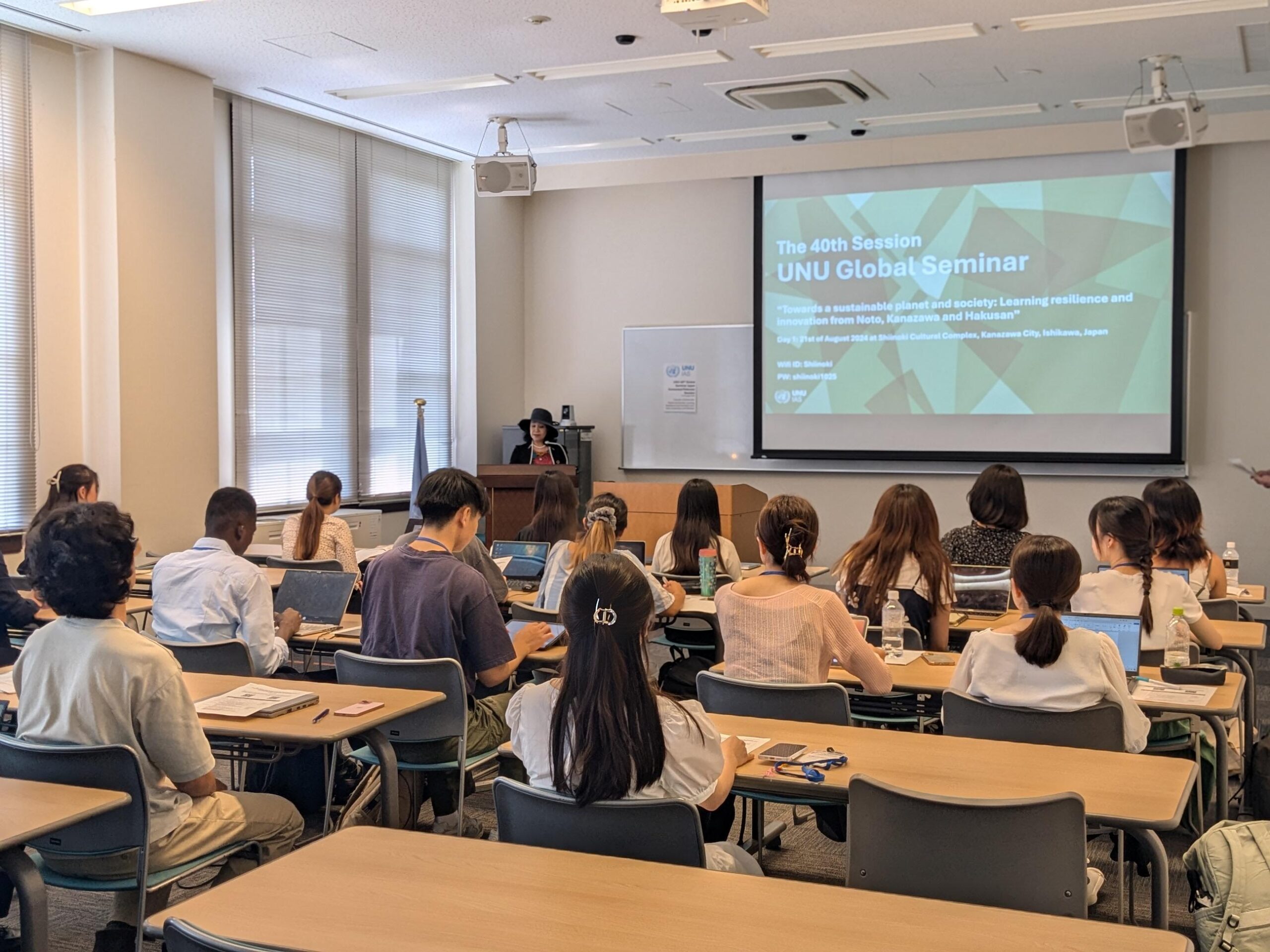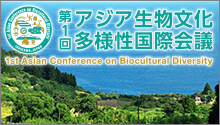From August 21 to 24, 2024, the 40th Global Seminar of the United Nations University, titled “Towards a Sustainable Earth and Society: Learning Resilience and Innovation from Noto, Kanazawa, and Hakusan,” was held in Kanazawa City and Hakusan City, Ishikawa Prefecture. It was attended by 21 participants from six countries, including Japan.
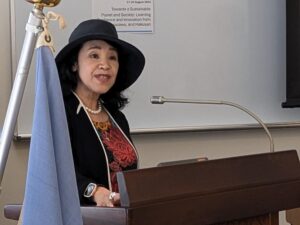
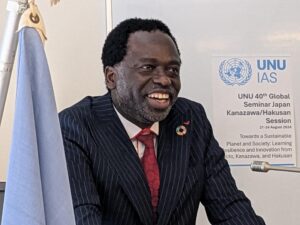
At the opening ceremony, Shinobu Yamaguchi, Director of the United Nations University Institute for the Advanced Study of Sustainability (UNU-IAS), delivered the opening remarks. She emphasized the importance of understanding regional challenges in sustainable development and finding optimal solutions accordingly.
Following her speech, Rector of UNU Prof. Tshilidzi Marwala gave a keynote address explaining how technology, sustainability, and social equity intersect to help us tackle global challenges. He also pointed out the crucial role of biodiversity in sustainable development, highlighting that its loss could pose serious risks due to climate change and urbanization. He stressed the importance of considering biodiversity in policy-making and promoting conservation efforts through collaboration among various stakeholders for future generations.
Lecture 1: “ Urban Nature Preservation and Sustainable Development.”
The first lecture was presented by Dr. Juan Pastor-Ivars, a researcher at the United Nations University OUIK, who spoke on “ Urban Nature Preservation and Sustainable Development.” He highlighted the vital role of urban nature, such as gardens and sacred forests, in implementing climate change adaptation strategies, using his research in Kanazawa as an example. He further added that urban nature contributes to biodiversity and cultural diversity.
Field Visit and Cultural Experience

After Dr. Juan’s lecture, the participants experienced a traditional Japanese tea ceremony at the Gyokusen’inmaru Garden in Kanazawa Castle Park. This garden, recreated in 2013 based on archaeological studies and historical documents, serves as a site for urban nature regeneration after being extinct during the Meiji period. Participants enjoyed delicious matcha and seasonal wagashi while learning about the history of Kanazawa. Subsequently, they visited Kanazawa Castle Park and Kenrokuen Garden to learn about the unique garden culture of Kanazawa and the crucial role that gardens play in biodiversity.
Lecture 2: Noto’s Satoyama and Satoumi GIAHS Site ― Current Situation and Creative Recovery from the Earthquake Utilizing Noto’s Unique Qualities
The second day began with a lecture by Sayako Koyama, Research Fellow at UNU-IAS OUIK, on the topic “Noto’s Satoyama and Satoumi GIAHS Site ― Current Situation and Creative Recovery from the Earthquake Utilizing Noto’s Unique Qualities”. She introduced local challenges such as depopulation and abandoned farmland that the region had faced even before the earthquake, emphasizing the importance of younger generations understanding regional attractions, values, and challenges to actively engage in recovery. She discussed perspectives on disaster prevention and mitigation utilizing ecosystems, and the importance of coordinating with ongoing initiatives related to globally important agricultural heritage and the release of the Japanese crested ibis, especially in light of the 2024 Noto Peninsula earthquake recovery. Koyama also presented her research on utilizing well water during water outages post-earthquake, underscoring the importance of securing water in emergencies towards realizing a resilient society. She noted the emergence of new community interactions in the recovery process and stated that the creative recovery developments in Noto could serve as a model for other regions.
Lecture 3: Disaster Prevention and Reduction & ESD
Next, Professor Yukihiko Oikawa, Deputy Director of Nara University of Education ESD-SDGs gave a presentation on “Disaster Prevention and Reduction & ESD”. He emphasized the importance of integrating disaster risk reduction and climate change education into Education for Sustainable Development (ESD), sharing lessons learned from the Great East Japan Earthquake. Oikawa also stated that addressing climate change through the SDGs and education is essential for achieving other goals, underlining that improving regional sustainability requires collaboration among diverse stakeholders.
Afterward, the participants moved to the second venue in Shiramine, Hakusan City.
An orientation session was held by Takashi Yamaguchi, director of Shiramine Nature School, during which explanations about the lifestyle, culture, and traditions of the Shiramine region were given.
Lecture 4: Climate Change and Health
The next lecture was presented by Yasushi Katsuma from UNU-IAS on the theme of “Climate Change and Health.” The discussion focused particularly on the impact of climate change on health, especially “climate anxiety” among young people. It was pointed out that while young people participating in climate change activities can have positive effects on their mental health, they may also feel overwhelmed by the scale of the issue. There is a growing call for further research on the relationship between climate change and mental health.
Lecture 5: International Frameworks and Challenges for Ecosystem Conservation
On the third day of the seminar, the topic was “International Frameworks and Challenges for Ecosystem Conservation,” delivered by Tsunao Watanabe, Director of UNU-IAS OUIK. The starting point of nature conservation, notably the system of national parks, was emphasized, particularly the history of Japan’s national parks and the importance of biodiversity conservation. It was also noted that environments where human activities coexist with nature, such as satoyama-satoumi areas, contribute to biodiversity conservation. The lecture highlighted the importance of many people, including young individuals, becoming involved in nature conservation activities and referred to the international goal of “30by30,” which aims for ecosystem restoration by 2030. This encourages young people to play a role at the forefront of nature conservation and promotes actions for a sustainable future.
Lecture 6: Characteristics and Activities of Hakusan-Tedorigawa UNESCO Global Geopark and Mount Hakusan Biosphere Reserve
In a lecture titled “Characteristics and Activities of Hakusan-Tedorigawa UNESCO Global Geopark and Mount Hakusan Biosphere Reserve” Susan May from the Hakusan-Tedorigawa UNESCO Global Geopark Council introduced nature conservation activities in the Hakusan region. This area is designated as both a Global Geopark and a Biosphere Reserve, promoting the conservation of the natural environment and sustainable regional development. The geopark aims to utilize the region’s natural heritage through education, research, and tourism, striving for a sustainable society where nature and humans coexist. Activities have been undertaken to encourage participation from students and local residents to enhance community pride and knowledge, with particular attention to poster presentations by high school students and activities at international forums, showcasing the contributions of young people to the future of nature conservation.
Lecture 7: Promoting ESD Using Geoparks and Biosphere Reserves
In a lecture titled “Promoting ESD Using Geoparks and Biosphere Reserves,” Associate Professor Aida Mammadova from Kanazawa University emphasized the importance of education for sustainable development (ESD) towards a sustainable society. The lecture introduced educational initiatives that leverage UNESCO’s Biosphere Reserves and Geoparks to solve local issues and learn about culture while aiming to achieve Sustainable Development Goals (SDGs).
Activities targeting young people are also active, with increasing opportunities for youth to engage in discussions about biodiversity and climate change through initiatives like the UNESCO MAB Youth Forum and Young Scientists Award. The lecture also mentioned Kanazawa University’s collaboration with local communities and international organizations in providing educational programs aimed at sustainable development.
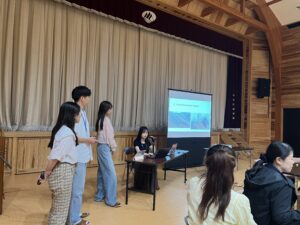

In the afternoon of the third day, participants were divided into groups for discussion sessions and presentations. They formed groups focused on biodiversity, disaster prevention and resilience, and education, proposing solutions to various challenges.
On the final day, the group explored the Hakusan National Park, learning about the utilization of satoyama and disaster prevention systems, such as sediment control.
The 40th UNU Global Seminar provided a valuable opportunity to deeply learn about the importance of local knowledge and coexistence with nature in achieving a sustainable earth and society. Participants reflected on resilience and innovation through the nature and culture of Kanazawa and Hakusan, gaining new perspectives on concrete challenges. It is hoped that this learning will contribute to achieving sustainable development goals in various countries, and ongoing collaboration beyond diverse nations and regions is encouraged.


